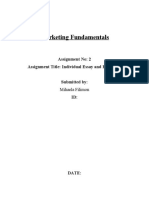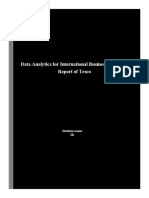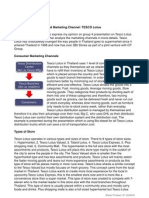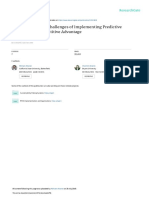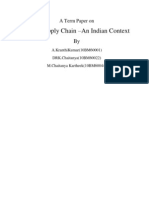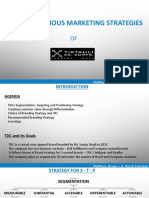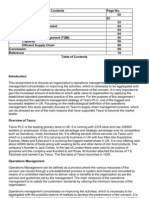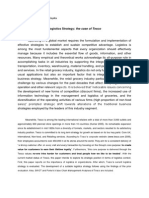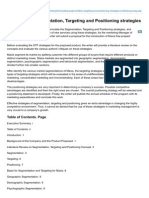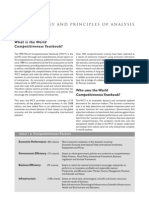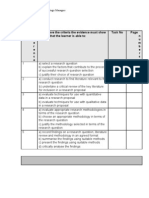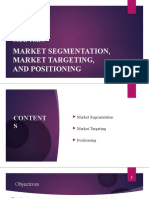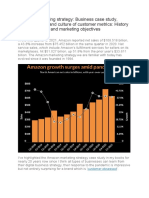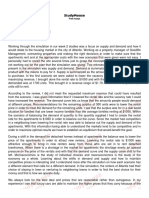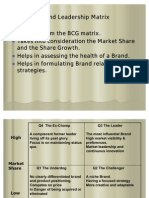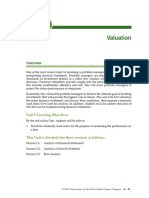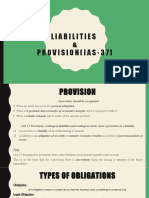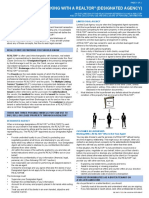Professional Documents
Culture Documents
Tesco Strategic Marketing
Tesco Strategic Marketing
Uploaded by
MIHAELACARMEN OLTIANU100%(1)100% found this document useful (1 vote)
86 views20 pagesThis document provides an overview and analysis of Tesco's strategic marketing objectives and approach. It discusses Tesco's market size and trends, SWOT and PESTLE analyses, competitors, and key stakeholders. The presentation aims to identify Tesco's strategic marketing objectives such as improving customer position, reducing prices, and expanding internationally. It analyzes Tesco's strengths, weaknesses, opportunities, and threats, as well as the political, economic, social, and technological factors influencing it. Major competitors like Asda, Sainsbury's, and Morrisons are also examined.
Original Description:
business
Copyright
© © All Rights Reserved
Available Formats
PDF, TXT or read online from Scribd
Share this document
Did you find this document useful?
Is this content inappropriate?
Report this DocumentThis document provides an overview and analysis of Tesco's strategic marketing objectives and approach. It discusses Tesco's market size and trends, SWOT and PESTLE analyses, competitors, and key stakeholders. The presentation aims to identify Tesco's strategic marketing objectives such as improving customer position, reducing prices, and expanding internationally. It analyzes Tesco's strengths, weaknesses, opportunities, and threats, as well as the political, economic, social, and technological factors influencing it. Major competitors like Asda, Sainsbury's, and Morrisons are also examined.
Copyright:
© All Rights Reserved
Available Formats
Download as PDF, TXT or read online from Scribd
Download as pdf or txt
100%(1)100% found this document useful (1 vote)
86 views20 pagesTesco Strategic Marketing
Tesco Strategic Marketing
Uploaded by
MIHAELACARMEN OLTIANUThis document provides an overview and analysis of Tesco's strategic marketing objectives and approach. It discusses Tesco's market size and trends, SWOT and PESTLE analyses, competitors, and key stakeholders. The presentation aims to identify Tesco's strategic marketing objectives such as improving customer position, reducing prices, and expanding internationally. It analyzes Tesco's strengths, weaknesses, opportunities, and threats, as well as the political, economic, social, and technological factors influencing it. Major competitors like Asda, Sainsbury's, and Morrisons are also examined.
Copyright:
© All Rights Reserved
Available Formats
Download as PDF, TXT or read online from Scribd
Download as pdf or txt
You are on page 1of 20
TESCO
Strategic Marketing
MG529 Strategic Marketing – Group Presentation
Presented by :
Cristina Elena Facaoaru – ID 21907937
Nicu-Alexandru Facaoaru – ID 21907938
Vasile Marian Moraru – ID 21907943
Balasubramaniam Balasubramaniam – ID 21901951
Introduction
The presentation will identify
• The objectives of TESCO’s Strategic Marketing
And will cover the following:
o Marketing size and trend date
o SWOT and PESTLE Analysis
o Competitor Analysis
o Stakeholder (and Customer) Analysis
Key Information About TESCO
• Founded in 1919 by Jack Cohen
• UK’s favorite and biggest supermarket
• The brand offers products and services
• Number of employees: 440,000 (2018)
• Annual Revenue: £57,491 Million (2018)
• Profit: £ 1,208 Million (2018)
TESCO
Market Size and trend Date
• Founded in 1919 by Jack Cohen
• UK’s favorite and biggest supermarket
• The brand offers products and services
• Number of employees: 440,000 (2018)
• Annual Revenue: £57,491 Million (2018)
• Profit: £ 1,208 Million (2018)
• TESCO hold over 28.4% of the overall
market share in UK. UK & ROI sales for
2021: £48.8 bn and estimated profit before
tax for 2021 is £825 m
TESCO
The Objectives of Strategic
Marketing
• Improve customer position.
• Cut down price
• Create highly valued brand
• To be strong in non-food business
• International Expansion
SWOT & PESTLE Analysis
• While PESTLE analyses the external factors
that can influence a business, SWOT
analysis focuses on the internal factors,
strengths and weaknesses of a business.
• Business managers use PESTLE and SWOT
analysis to make major decisions.
• By assessing the influence of internal and
external factors on the business, the
management team obtains a comprehensive
evaluation of TESCO as a business.
TESCO’s SWOT Analysis
Tesco’s Strengths
With a growing number of stores, Tesco is already a
global business: If in 2008 Tesco operated 3,751 retail
stores, now the Tesco network is expanded to 14
countries and includes over 6,966 stores. The addition of
new stores in the operational chain has led to an
increase in the revenue of business.
Reliable and efficient supply chain and superior
technologies used in the sales process: Using a
simplified business model, efficient waste management
policies and reduced incurring costs, Tesco has
managed to build an efficient distribution network. To
count the products automatically, Tesco has introduced
the RFID - barcode system, a mobile payment
application and advanced M-commerce facilities.
TESCO’s SWOT Analysis
Tesco’s Weaknesses
Fraud and accounting scandal in 2017: Due to false
accounting statements and misappropriation of profits,
Tesco was accused of fraud and received substantial
fines.
Financial errors and unfair business practices:
Tesco's financial profits were severely affected by very
large financial debts and uncovered obligations on
credit cards. As it recently turned out, Tesco prevented
the owners from renting their properties to those
supermarkets very close located to its stores, such
restrictions being illegal and unethical.
TESCO’s SWOT Analysis
Tesco’s Opportunities
Price equalization: As recently announced, for most
items, Tesco has adjusted its prices to those of its
rival Aldi. Using this strategy, Tesco managed to stop
and reverse the loss of market share to Aldi.
Online sales: This opportunity, along with the
development of home delivery services, will lead to
the growth and modernization of the Tesco business.
TESCO’s SWOT Analysis
Tesco’s Threats
Fake Farm legal threat in 2017: Due to the
misleading of customers as a result of the selling food
under the false name of "Woodside Farms", Tesco
faced severe legal threat procedures.
Supply Chain Issues: These issues have determined
that Tesco's operations and profitability to be
threatened by shortages. When its supply chain was
disrupted by a recent health crisis, Tesco was forced
to limit the essential items a customer could buy.
TESCO’s PESTLE Analysis
POLITICAL FACTORS
• Government Regulation: Because the retailer is a
multinational brand and operate its business in different
countries across the world, Tesco should make decisions
according to different government and political regulations.
• Brexit Deal: The Brexit has created an environment of
uncertainty in the business community. The chairman of
Tesco, said that Brexit would increase the prices by 3% to
5%. Even if the deal would include tariff-free, there is
involved administration cost.
TESCO’s PESTLE Analysis
ECONOMICAL FACTORS
TESCO’s PESTLE Analysis
TESCO’s PESTLE Analysis
TESCO’s PESTLE Analysis
TESCO’s PESTLE Analysis
TESCO
Competitors Analysis
The main competitors of TESCO are:
ASDA -14.1% of market share
SAINSBURY – 16.9% of market share
MORISONS – 10.14% of market share
WAITROSE
LIDL – German global retailer
ALDI – German global retailer
TESCO
Stakeholders Analysis
Internal Stakeholders: employees, managers, board and
executive committee, shareholders.
External Stakeholders: customers, suppliers, creditors,
competitors, government.
Stakeholders have different influences and expectations that can
generate different conflicts. For example, suppliers wait for
payment on time while the TESCO management team tries to
consolidate the company's financial position by delaying payments.
Where TESCO operates, many small shops have closed, which
proves that in some situations, Tesco's activity can negatively
influence small competitors.
High salaries of employees and managers generate lower profits
and may upset shareholders who expect high profits from the
investments made.
Conclusion
To summarize, the retailer Tesco has a huge market
potential in the food industry. Tesco could increase its
revenue and compete effectively with its rivals if it uses
effective marketing tools and strategic decisions-making.
While PESTLE analysis highlights that Tesco is on the top
supermarkets in the UK and around the world, SWOT
analysis point out that processes, controversies and
uncertain economic environment are serious threats to the
company. The company should keep its eyes open for
changing laws and regulations.
REFERENCES
1. Business Writer (2020, June 4). Tesco shares a fall by 6%. The Irish
Times
2. Davis, A. (2018) Competition law – the basics, Available at:
https://www.pinsentmasons.com/out-law/guides/competition-law—the-
basics ( Accessed 27 October 2021)
3. Tesco (2020) Available at:
https://www.tescoplc.com/sustainability/downloads/religious-slaughter-
policy/ (Accessed 28 October 2021)
4. Vizard, S. (2020, March 5). Tesco becomes the first supermarket to
directly price match with Aldi. Marketing Week
5. Weston, P. (2019) Tesco vows to remove one billion pieces of plastic
packaging by end of 2020, Available at:
https://www.independent.co.uk/environment/tesco-plastic-packaging-
waste-bags-environment-trays-lids-a9180691.html (Accessed 28
October 2021)
6. Wood, Z. (2020, February 14). Tesco stopped rivals opening nearby
stores, watchdog finds. The Guardian
7. Wilson, B. (2020, March 8). Tesco limits sales of essential items. BBC
News
You might also like
- Marketing Fundamentals: Assignment No: 2 Assignment Title: Individual Essay and ReflectionDocument15 pagesMarketing Fundamentals: Assignment No: 2 Assignment Title: Individual Essay and ReflectionFahim KhanNo ratings yet
- TescoDocument20 pagesTescomyservices 000100% (1)
- Business Plan - X Real Estate CompanyDocument13 pagesBusiness Plan - X Real Estate Companyzainu27No ratings yet
- McDonalds Monopoly Case StudyDocument3 pagesMcDonalds Monopoly Case Studyanitasengarphd100% (1)
- Comm 223Document26 pagesComm 223Sophie Dickins100% (1)
- Interpretive Marketing ResearchDocument18 pagesInterpretive Marketing ResearchJohanna Moisander100% (3)
- LUX Vs DOVE Brand PositioningDocument5 pagesLUX Vs DOVE Brand PositioningWajid Ali86% (14)
- Strategic Marketing of TESCO KhanDocument12 pagesStrategic Marketing of TESCO KhanKhan Humaira100% (1)
- Tesco PresentationDocument12 pagesTesco PresentationRuslan ZhivkovNo ratings yet
- Marketing Channels On TescoDocument3 pagesMarketing Channels On TescoWissut Prutisart100% (2)
- Marketing StrategiesDocument3 pagesMarketing StrategiesJoshua TobiNo ratings yet
- Study On Operational Excelleance and Management Professionals Skill Set Requirement-Special Rerefence To Pharma Industries in BangaloreDocument11 pagesStudy On Operational Excelleance and Management Professionals Skill Set Requirement-Special Rerefence To Pharma Industries in BangaloreSujatha NNo ratings yet
- Opportunities and Challenges of Implementing Predictive Analytics For Competitive AdvantageDocument27 pagesOpportunities and Challenges of Implementing Predictive Analytics For Competitive AdvantageShaban KimuyuNo ratings yet
- Digital Marketing Plan Marks and SpencerDocument18 pagesDigital Marketing Plan Marks and SpencerReswinNo ratings yet
- Introduction e CommerceDocument84 pagesIntroduction e CommerceMohd FirdausNo ratings yet
- Retail Supply Chain - FinalDocument9 pagesRetail Supply Chain - FinalKranthi KumarNo ratings yet
- Tesco: Principles of MarketingDocument10 pagesTesco: Principles of MarketingBeenish Jahanzeb100% (2)
- Competitive Strategy ChinaDocument15 pagesCompetitive Strategy ChinaDhiraj Sharma100% (1)
- Tesco: Losing Ground in The UK Case AnalysisDocument9 pagesTesco: Losing Ground in The UK Case AnalysisLeena SalamNo ratings yet
- Study of Various Marketing Strategies: Pgpmex Group - 6, Great LearningDocument12 pagesStudy of Various Marketing Strategies: Pgpmex Group - 6, Great LearningDipanwita GhoshNo ratings yet
- Unit Digital MarketingDocument72 pagesUnit Digital MarketingAsghar Ali QureshiNo ratings yet
- End Chapter Case Study: Customer Satisfaction Program of Godrej and Boyce Limited (GBL)Document9 pagesEnd Chapter Case Study: Customer Satisfaction Program of Godrej and Boyce Limited (GBL)IshachowrasiaNo ratings yet
- Impact of Price On Purchasing DecisionsDocument11 pagesImpact of Price On Purchasing Decisionsranga.ramanNo ratings yet
- Project Title "'Analysis of Profitability of Banks: Comparative Study of Private and Public Sector Bank''Document55 pagesProject Title "'Analysis of Profitability of Banks: Comparative Study of Private and Public Sector Bank''ProsNo ratings yet
- Marketing Management-1 Cases Dr. Gunjan A Rana: Case 1-Indian Automobiles Market: Low On Marketing OrientationDocument20 pagesMarketing Management-1 Cases Dr. Gunjan A Rana: Case 1-Indian Automobiles Market: Low On Marketing OrientationSimran VaniNo ratings yet
- MARKETING ASSIGNMENTen PDFDocument30 pagesMARKETING ASSIGNMENTen PDFBalance JamesNo ratings yet
- Internet Marketing StrategyDocument14 pagesInternet Marketing StrategyBDNKNo ratings yet
- Managing Communication (Assignment)Document4 pagesManaging Communication (Assignment)Research-duniya DuniyaNo ratings yet
- Operation MGT at TescoDocument7 pagesOperation MGT at TescoAl AminNo ratings yet
- Marketing AMDDocument5 pagesMarketing AMDMukund KabraNo ratings yet
- STP Strategy For New Product Launch-A Work in Progress: Tahsina KhanDocument10 pagesSTP Strategy For New Product Launch-A Work in Progress: Tahsina KhanGreeshmaNo ratings yet
- Operations Management in TescoDocument6 pagesOperations Management in TescoYogesh Lokhande100% (1)
- HRM3007 Assignments 2017 MyanmarDocument10 pagesHRM3007 Assignments 2017 MyanmarDominNo ratings yet
- 2Document5 pages2zohreh hosseinzadehNo ratings yet
- TESCODocument19 pagesTESCOEmmanuel OkemeNo ratings yet
- Final Project Modified New (A Project Report On Customer Relaionship Managment With Reference To HyundaiDocument46 pagesFinal Project Modified New (A Project Report On Customer Relaionship Managment With Reference To Hyundairaghu100% (1)
- Delivering Success Tesco PerformanceDocument10 pagesDelivering Success Tesco Performancebakhoo12No ratings yet
- Advertising Plan &advertising Campaign & BudgetDocument37 pagesAdvertising Plan &advertising Campaign & Budgetsantanu banerjee100% (1)
- Impact of Digital Transformation On Employment in Banking SectorDocument6 pagesImpact of Digital Transformation On Employment in Banking SectorHARSH MALPANINo ratings yet
- Direct Marketing of Insurance Integration of Marketing, Pricing and UnderwritingDocument21 pagesDirect Marketing of Insurance Integration of Marketing, Pricing and UnderwritingRufus ChettiarNo ratings yet
- CHAPTER 3 Analyzing The Marketing EnvironmentDocument18 pagesCHAPTER 3 Analyzing The Marketing EnvironmentMarvin KatendeNo ratings yet
- McDonalds Think Global Act Local - The MarketingDocument16 pagesMcDonalds Think Global Act Local - The Marketingmoonjj100% (1)
- Industry AnalysisDocument7 pagesIndustry AnalysisRachel TangNo ratings yet
- Unit 2 - Marketing Processes and PlanningDocument11 pagesUnit 2 - Marketing Processes and PlanningNashNo ratings yet
- Management Reward SystemsDocument19 pagesManagement Reward SystemsRajan KumarNo ratings yet
- Marketing EnviDocument18 pagesMarketing EnviRrnkp GalzNo ratings yet
- Measuring Customer Relationship Management (CRM) in The Hospitality Industry of Some Selected Hotels in Accra, Ghana: The Role of Information and Communication Technologies (ICTs)Document10 pagesMeasuring Customer Relationship Management (CRM) in The Hospitality Industry of Some Selected Hotels in Accra, Ghana: The Role of Information and Communication Technologies (ICTs)International Journal of Application or Innovation in Engineering & ManagementNo ratings yet
- Formulating Segmentation Targeting and Positioning StrategiesDocument15 pagesFormulating Segmentation Targeting and Positioning StrategiesBridgestone55100% (1)
- Basics of Financial Accounting BDAW2103Document7 pagesBasics of Financial Accounting BDAW2103geena1980No ratings yet
- Imd MethodologyDocument5 pagesImd MethodologyselveenNo ratings yet
- Dissimilarity of E-Marketing Vs Traditional MarketingDocument7 pagesDissimilarity of E-Marketing Vs Traditional Marketingdzero2No ratings yet
- Conceptual Foundations of Marketing and Marketing TheoryDocument8 pagesConceptual Foundations of Marketing and Marketing Theoryanon_3868846270% (1)
- Defining MarketingDocument18 pagesDefining MarketingSairam PentaNo ratings yet
- PGBM16 Global Corporate Strategy Aug 2011Document5 pagesPGBM16 Global Corporate Strategy Aug 2011cnu_neveb4No ratings yet
- Knowledge Management and Predictive Analytics in IT Project RisksDocument8 pagesKnowledge Management and Predictive Analytics in IT Project RisksEditor IJTSRDNo ratings yet
- Unit Code: BM533 Unit Title: Contemporary Business EconomicsDocument17 pagesUnit Code: BM533 Unit Title: Contemporary Business EconomicsLucifer 3013100% (1)
- Research Methods For Strategic ManagersDocument5 pagesResearch Methods For Strategic ManagersAyesha Sarfaraz0% (3)
- International Marketing Plan GuideDocument24 pagesInternational Marketing Plan GuideKhanh Lê HuỳnhNo ratings yet
- CHAPTER 5 - Market Segmentation, Market Targeting, and PositioningDocument74 pagesCHAPTER 5 - Market Segmentation, Market Targeting, and PositioningXuân MaiNo ratings yet
- TescoDocument16 pagesTescoMIHAELACARMEN OLTIANUNo ratings yet
- Ua Business StrategyDocument23 pagesUa Business Strategyrakshika somrajanNo ratings yet
- M003lon Cw2 Sample PaperDocument17 pagesM003lon Cw2 Sample PaperShreyan ChowdhuryNo ratings yet
- Tesco Case Study For SM AssignmentDocument3 pagesTesco Case Study For SM AssignmentMIHAELACARMEN OLTIANUNo ratings yet
- Amazon StartegyDocument24 pagesAmazon StartegyMIHAELACARMEN OLTIANUNo ratings yet
- TescoDocument16 pagesTescoMIHAELACARMEN OLTIANUNo ratings yet
- Supply and DemandDocument2 pagesSupply and DemandMIHAELACARMEN OLTIANUNo ratings yet
- Principles of Marketing: Seventeenth EditionDocument39 pagesPrinciples of Marketing: Seventeenth EditionAtang Wadi100% (1)
- The Philippine Cacao IndustryDocument2 pagesThe Philippine Cacao IndustryMonkey D. LuffyNo ratings yet
- Negocios I l2 GlobalizationDocument26 pagesNegocios I l2 GlobalizationcsilvasilvNo ratings yet
- Chapter 6Document49 pagesChapter 6Trần Minh ThuNo ratings yet
- Module 3 - BusimathDocument5 pagesModule 3 - BusimathAcelin Rayelle TULAGANNo ratings yet
- Brand Leadership MatrixDocument4 pagesBrand Leadership MatrixAbhishek PrabhakarNo ratings yet
- Next Generation Investment ProgramDocument9 pagesNext Generation Investment ProgramDavin ClarkeNo ratings yet
- 3.2 - Market Research - IGCSE AIDDocument5 pages3.2 - Market Research - IGCSE AIDManeeta KaurNo ratings yet
- FINA2004 Unit 5Document11 pagesFINA2004 Unit 5Taedia HibbertNo ratings yet
- Production Function - Handwritten Notes - (Aarambh 2024)Document10 pagesProduction Function - Handwritten Notes - (Aarambh 2024)Pranjal GuptaNo ratings yet
- Amaravati Circle & BranchesDocument312 pagesAmaravati Circle & BranchesUday kumarNo ratings yet
- Eastwest ConformeDocument1 pageEastwest Conformewrapcarmanila888No ratings yet
- ProvisionDocument15 pagesProvisionAtka FahimNo ratings yet
- Ceramic Industry in BangladeshDocument3 pagesCeramic Industry in BangladeshFarah ĐêěbåNo ratings yet
- ACC 201 Final Project WorkbookDocument40 pagesACC 201 Final Project WorkbookSwapan Kumar SahaNo ratings yet
- Impairment of AssetsDocument21 pagesImpairment of AssetsDeryl GalveNo ratings yet
- Working With A REALTOR Rev Jun2014 DADocument2 pagesWorking With A REALTOR Rev Jun2014 DAnicholas alexanderNo ratings yet
- Agent/ Intermediary Name and Code:POLICYBAZAAR INSURANCE BROKERS PRIVATE LIMITED BRC0000434Document5 pagesAgent/ Intermediary Name and Code:POLICYBAZAAR INSURANCE BROKERS PRIVATE LIMITED BRC0000434hiteshmohakar15No ratings yet
- New Electronic Trading Systems in The Foreign Exchange MarketsDocument37 pagesNew Electronic Trading Systems in The Foreign Exchange MarketsDev GogoiNo ratings yet
- Discussion Topic Is Entry N Exits in Trades and Portfolio HoldingsDocument3 pagesDiscussion Topic Is Entry N Exits in Trades and Portfolio HoldingsDASI SAI TEJANo ratings yet
- Checklist Requirements For The Financial PlanDocument14 pagesChecklist Requirements For The Financial PlanXyran AlejandroNo ratings yet
- Informal Industrial Agglomeration: Submitted ToDocument9 pagesInformal Industrial Agglomeration: Submitted ToKhaled KhanNo ratings yet
- 2010 Canvassing 1-30 PDFDocument30 pages2010 Canvassing 1-30 PDFdesignhausNo ratings yet
- Acctg For Special Transaction - Second Lesson PDFDocument6 pagesAcctg For Special Transaction - Second Lesson PDFDebbie Grace Latiban LinazaNo ratings yet
- CivilCode BookIV TITLE IX PartnershipDocument27 pagesCivilCode BookIV TITLE IX PartnershipsheraldineNo ratings yet
- Comparison Chart For Guaranty Pledge and MortgageDocument12 pagesComparison Chart For Guaranty Pledge and MortgageMarishiNo ratings yet
- Regional Integration Functions and FormsDocument26 pagesRegional Integration Functions and FormsTafwaza JereNo ratings yet
- ACT 201 Chapter 2 (Journal, Ledger & Trial Balance - Practice Problem Solution)Document7 pagesACT 201 Chapter 2 (Journal, Ledger & Trial Balance - Practice Problem Solution)MD SHAFIN AHMED0% (1)
